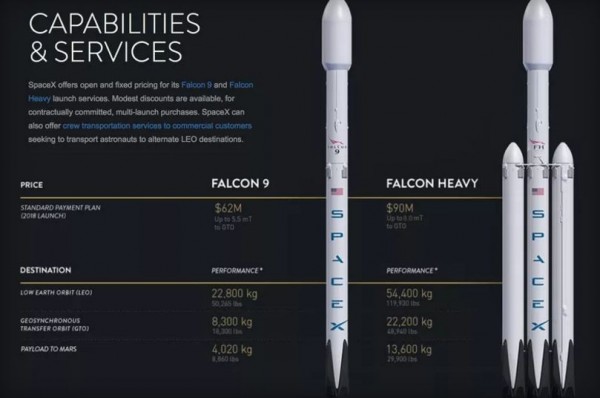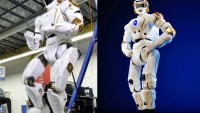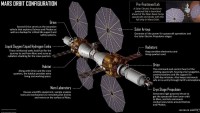SpaceX will Beat NASA to Mars
| Arthur Dominic Villasanta | | May 31, 2016 03:28 AM EDT |
(Photo : SpaceX) Falcon 9 and Falcon Heavy
Odds are SpaceX will beat NASA in the contest to land the first humans on Mars but that hasn't altered NASA's current view of SpaceX as a partner and not a competitor in the "Race to the Red Planet."
Stephen Jurczyk, Associate Administrator of NASA's Space Technology Mission Directorate, said NASA views the proposed landing of the Red Dragon spacecraft on Mars by 2018 as an opportunity for both NASA and SpaceX to share the load in the campaign to get humans to Mars.
Like Us on Facebook
He said SpaceX, which was founded by Elon Musk, needs NASA's Deep Space Network of communication stations and other space flight infrastructure to successfully make the Mars landing. For its part, NASA could learn a lot from a successful landing of the Red Dragon spacecraft and is excited about SpaceX's plans to land Red Dragon on Mars using the untested supersonic retro-propulsion technology.
"Landing the Red Dragon there would definitely be an advancement," said Jurczyk. "We know how to land one metric ton on Mars, the Red Dragon is five to six metric tons.
"We are in collaboration with SpaceX because we want the entry descent and landing data from that landing, and particularly we want the supersonic retro-propulsion data."
Jurczyk said that since 1976, NASA has used supersonic parachutes to slow down from supersonic speeds to subsonic speeds on re-entry. NASA then used retro-propulsion and later airbags and most recently a sky crane landing.
"But we've never used supersonic retro-propulsion to get a craft from supersonic speed to subsonic speed for landing on Mars. So we really want that data."
If SpaceX and NASA can keep to their promises, SpaceX should land humans on Mars by 2028. NASA plans to accomplish this feat by 2035.
Jurczyk emphasized NASA will stick to its three-part plan to get to Mars. The first part is the "Earth-dependent phase" in low-Earth orbit (LEO) where activities and experiments aboard the International Space Station (ISS) advance the research and technology necessary for a trek to Mars and staying there.
Part two is what NASA calls the "proving ground." This includes missions to the vicinity of the Moon or cislunar space.
Among these missions is a lunar habitat that will go into a stable lunar orbit in the cislunar space around the Moon. This space station will be NASA's base in the lunar vicinity. It will test NASA's very high-efficiency propulsion technology; environmental control and life-support system technologies.
The proposed lunar space station was recently unveiled by Orbital ATK and consists of mating together two upgraded versions of their Cygnus spacecraft. Orbital ATK wants to have the habitat in lunar orbit by 2020.
Another project is to land the Resource Prospector Rover (now under development) on the Moon to look for frozen water in shadowy craters. This will tell NASA how difficult it might be to liberate frozen water from the Martian regolith. Martian water will be used for drinking and its oxygen and hydrogen components for fuel.
Part three is the Mars landing. Jurczyk said NASA must develop the capability to land 19 to 23 metric tons, or the weight of an unfueled ascent vehicle for a crew. That weight assumes the astronauts will have the capability to produce fuel in-situ on Mars.
"Then there is all the surface infrastructure," noted Jurczyk. "That's the technology we need to develop over the next 10 years so that we can have people on the surface in the 2030s. We need to be able to land much heavier payloads, develop and generate surface power, in-situ resource utilization, habitation, better spacesuits, etc."
TagsSpaceX, NASA, Mars, Stephen Jurczyk
©2015 Chinatopix All rights reserved. Do not reproduce without permission
EDITOR'S PICKS
-

Did the Trump administration just announce plans for a trade war with ‘hostile’ China and Russia?
-

US Senate passes Taiwan travel bill slammed by China
-

As Yan Sihong’s family grieves, here are other Chinese students who went missing abroad. Some have never been found
-

Beijing blasts Western critics who ‘smear China’ with the term sharp power
-

China Envoy Seeks to Defuse Tensions With U.S. as a Trade War Brews
-

Singapore's Deputy PM Provides Bitcoin Vote of Confidence Amid China's Blanket Bans
-

China warns investors over risks in overseas virtual currency trading
-

Chinese government most trustworthy: survey
-

Kashima Antlers On Course For Back-To-Back Titles
MOST POPULAR
LATEST NEWS
Zhou Yongkang: China's Former Security Chief Sentenced to Life in Prison

China's former Chief of the Ministry of Public Security, Zhou Yongkang, has been given a life sentence after he was found guilty of abusing his office, bribery and deliberately ... Full Article
TRENDING STORY

China Pork Prices Expected to Stabilize As The Supplies Recover

Elephone P9000 Smartphone is now on Sale on Amazon India

There's a Big Chance Cliffhangers Won't Still Be Resolved When Grey's Anatomy Season 13 Returns

Supreme Court Ruled on Samsung vs Apple Dispute for Patent Infringement

Microsoft Surface Pro 5 Rumors and Release Date: What is the Latest?













